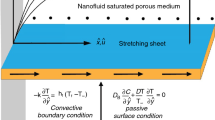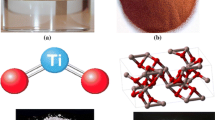Abstract
The researchers have diverted their mind to improve the thermophysical properties of convective heat transfer analysis. The studies on nanofluids have been reported because these systems display an anomalous enhancement of convective heat transfer. In this paper, we made a comparative analysis of Maxwell nanofluid with nanoparticles suspended in ethylene glycol through modern approaches of fractional differentiations. The governing equations of Maxwell nanofluid for velocity and temperature are fractionalized in terms of Atangana–Baleanu and Caputo–Fabrizio operators and then solved analytically by invoking Laplace transform to generate series solutions. The general solutions of temperature and velocity field are established in terms of Mittag–Leffler and Fox-H functions, respectively. Modern approaches of fractional differentiations have been analyzed for memory effects on the Maxwell nanofluid for improving the thermophysical properties. The impacts of rheological parameters are underlined for the volume fraction of nanoparticles, relaxation time and single- and multi-walled carbon nanotubes suspended in ethylene glycol. A graphical illustration is depicted to disclose the physical aspects of the problem based on the functionality of modern approaches of fractional differentiations. Our results suggest that thermal conductivity of Maxwell nanofluid increases when nanoparticle’s volume fraction increases.





Similar content being viewed by others
Abbreviations
- T(y, t):
-
Temperature distribution
- V(y, t):
-
Velocity field
- \(\lambda _1\) :
-
Relaxation time of nanofluid
- \(\rho _{\mathrm{nf}}\) :
-
Density of nanofluid
- \(k_{\mathrm{nf}}\) :
-
Thermal conductivity of nanofluid
- \((c_{\text{p}}\rho )_{\mathrm{nf}}\) :
-
Heat capacitance of nanofluid
- \((\beta )_{\mathrm{nf}}\) :
-
Thermal expansion coefficient of nanofluid
- \(\mu _{\mathrm{nf}}\) :
-
Dynamic viscosity of nanofluid
- t :
-
Time variable
- y :
-
Spatial variable
- \(T_\infty\) :
-
Constant wall temperature
- \(T_w\) :
-
Temperature rise up
- \(\mathfrak {R}_1-\mathfrak {R}_5\) :
-
Functional parameters
- \(\xi _1-\xi _2\) :
-
Fractional parameters
- \(\beta _1-\beta _18\) :
-
Letting parameters
- CF :
-
Caputo–Fabrizio fractional differential operator
- AB :
-
Atangana–Baleanu fractional differential operator
References
Choi SUS Enhancing thermal conductivity of fluids with nanoparticles, The Proceedings of the 1995 ASME International Mechanical Engineering Congress and Exposition, Vol. 66, ASME, San Francisco, USA 1995;99–105.
Buongiorno J. Convective transport in nanofluids. J.Heat Transf. 2006;128:240–50.
Domairry D, Sheikholeslami M, Ashorynejad HR, Gorla RS, Khani M. Natural convection flow of a non-Newtonian nanofluid between two vertical flat plates. J Nanoeng Nanosyst. 225(3):115–22.
Ali F, Gohar M, Khan I. MHD flow of water-based Brinkman type nanofluid over a vertical plate embedded in a porous medium with variable surface velocity, temperature and concentration. J Mol Liq. 2016;223:412–9.
Khan U, Ahmed N, Mohyud-Din ST. Heat transfer effects on carbon nanotubes suspended nanofluid flow in a channel with non-parallel walls under the effect of velocity slip boundary condition: a numerical study. Neural Comput Appl. 2017;28(1):37–46.
Ahmadi MH, Ahmadi MA, Nazari MA, Mahian O, Ghasempour R. A proposed model to predict thermal conductivity ratio of \(\text{ Al}_2\text{ O}_3/\text{EG }\) nanofluid by applying least squares support vector machine (LSSVM) and genetic algorithm as a connectionist approach. J Therm Anal Calorim. 2018;1:1–11.
Khalid A, Khan I, Sharidan S. Exact solutions for free convection flow of nanofluids with ramped wall temperature. Eur Phys J Plus. 2015;130:57–71.
Liu MS, Lin MCC, Huang IT, Wang CC. Enhancement of thermal conductivity with carbon nanotube for nanofluids. Int Commun Heat Mass Transf. 2005;32(9):1202–10.
Haq RU, Nadeem S, Khan ZH, Noor NFM. Convective heat transfer in MHD slip flow over a stretching surface in the presence of carbon nanotubes. Physica B Condensed Matter. 2015;457:40–7.
Abro KA, Irfan AA, Sikandar MA, Khan I. On the Thermal Analysis of Magnetohydrodynamic Jeffery Fluid via Modern Non Integer Order derivative. J King Saud Univ Sci. 2018;1:1–7.
Koca I, Atangana A. Solutions of Cattaneo-Hristov model of elastic heat diffusion with Caputo-Fabrizio and Atangana-Baleanu fractional derivatives. Therm Sci. 2017;21(6):2299–305.
Muzaffar HL, Kashif AA, Asif AS. Helical flows of fractional viscoelastic fluid in a circular pipe. Int J Adv Appl Sci. 2017;4(10):97–105.
Sheikh NA, Ali F, Saqib M, Khan I, Jan SAA, Alshomrani AS, Alghamdi MS. Comparison and analysis of the Atangana-Baleanu and Caputo-Fabrizio fractional derivatives for generalized Casson fluid model with heat generation and chemical reaction. Results Phys. 2017;7:789–800.
Ali F, Jan SAA, Khan I, Gohar M, Sheikh NA. Solutions with special functions for time fractional free convection flow of Brinkman-type fluid. Eur Phys J Plus. 2016;131(9):310–20.
Abro KA, Hussain M, Baig MM. Influences of magnetic field in viscoelastic fluid. Int J Nonlinear Anal Appl. 2018;9(1):99–109.
Atangana A. On the new fractional derivative and application to nonlinear Fisher’s reaction-diffusion equation. Appl Math Comput. 2016;273:948–56.
Alkahtani BST, Atangana A. Controlling the wave movement on the surface of shallow water with the Caputo?Fabrizio derivative with fractional order. Chaos Solitons Fractals. 2016;89:539–46.
Muhammad BR, Naseer AA, Atangana A, Muhammad IA. Couette flows of a viscous fluid with slip effects and non-integer order derivative without singular kernel. 2019;12(3):645–64.
Owolabi KM. Analysis and numerical simulation of multicomponent system with Atangana-Baleanu fractional derivative. Chaos Solitons Fractals. 2018;115:127–34.
Gómez-Aguilar JF. Space?time fractional diffusion equation using a derivative with nonsingular and regular kernel. Physica A Statist Mech Appl. 2017;465:562–72.
Owolabi KM. Modeling and simulation of a dynamical system with the Atangana-Baleanu fractional derivative. Eur Phys J Plus. 2018;133(15):1–9.
Abro KA, Ali DC, Irfan AA, Khan I. Dual thermal analysis of magnetohydrodynamic flow of nanofluids via modern approaches of Caputo-Fabrizio and Atangana-Baleanu fractional derivatives embedded in porous medium. J Therm Anal Calorim. 2018;1:1–11.
Atangana A, Baleanu D. New fractional derivatives with non-local and non-singular kernel: theory and application to heat transfer model. Therm Sci. 2016;20:763–9.
Abro KA, Khan I, Nisar KS. Novel technique of Atangana and Baleanu for heat dissipation in transmission line of electrical circuit. Chaos Solitons Fractals. 2019;129:40–5.
Atangana A. Non validity of index law in fractional calculus: a fractional differential operator with Markovian and non-Markovian properties. Physica A Statist Mech Appl. 2018;505:688–706.
Owolabi KM, Atangana A. Chaotic behavior in system of non-integer-order ordinary differential equations. Chaos Solitons Fractals. 2018;115:362–70.
Lohana B, Abro KA, Shaikh AW. Thermodynamical analysis of heat transfer of gravity?driven fluid flow via fractional treatment: an analytical study. J Therm Anal Calorim. 2020;. https://doi.org/10.1007/s10973-020-09429-w.
Gómez-Aguilar JF, Atangana A. New insight in fractional differentiation: power, exponential decay and Mittag-Leffler laws and applications. Eur Phys J Plus. 2017;132(13):1–23.
Awan AU, Ali M, Abro KA. Electroosmotic slip flow of Oldroyd-B fluid between two plates with non-singular kernel. J Comput Appl Math. 376 2(020):112885. https://doi.org/10.1016/j.cam.2020.112885.
Kashif AA, Ambreen S, Atangana A. Thermal stratification of rotational second-grade fluid through fractional differential operators. J Therm Anal Calorim. 2020;. https://doi.org/10.1007/s10973-020-09312-8.
Atangana A, Gómez-Aguilar JF. Decolonisation of fractional calculus rules: Breaking commutativity and associativity to capture more natural phenomena. Eur Phys J Plus. 2018;133:1–22.
Abro KA A fractional and analytic investigation of thermo-diffusion process on free convection flow: an application to surface modification technology, Eur Phys J Plus, https://doi.org/10.1140/epjp/s13360-019-00046-7.
Gómez-Aguilar JF. Fundamental solutions to electrical circuits of non-integer order via fractional derivatives with and without singular kernels. Eur Phys J Plus. 2018;133(5):1–21.
Kashif AA, Khan I, Gomez-Aguilar JF Heat transfer in magnetohydrodynamic free convection flow of generalized ferrofluid with magnetite nanoparticles, J Therm Anal Calorim, https://doi.org/10.1007/s10973-019-08992-1.
Mohamadian N, Ghorbani H, Wood D, Hormozi HK. Rheological and ?ltration characteristics of drilling fluids enhanced by nanoparticles with selected additives: an experimental study. Adv Geo Energy Res. 2018;2(3):228–36.
Cai J, Hu X, Xiao B, Zhou Y, Wei W. Recent developments on fractal-based approaches to nanofluids and nanoparticle aggregation. Int J Heat Mass Transf. 2017;105:623–37.
Esfe MH, Mahian O, Hajmohammad MH, Wongwises S. Design of a heat exchanger working with organic nanofluids using multi-objective particle swarm optimization algorithm and response surface method. Int J Heat Mass Transf. 2018;119:922–30.
Atangana A, Koca I. Chaos in a simple nonlinear system with Atangana-Baleanu derivatives with fractional order. Chaos Solitons Fractals. 2016;89:447–54.
Atangana A. Fractal-fractional differentiation and integration: Connecting fractal calculus and fractional calculus to predict complex system. Chaos Solitons Fractals. 2017;102:396–406.
Atangana A, Sania Q. Modeling attractors of chaotic dynamical systems with fractal-fractional operators. Chaos Solitons Fractals. 2019;123:320–37.
Gomez-Aguilar JF. Chaos and multiple attractors in a fractal-fractional Shinriki’s oscillator model. Physica A. 2019;. https://doi.org/10.1016/j.physa.2019.122918.
Kashif AA, Abdon A. Mathematical analysis of memristor through fractal-fractional differential operators: a numerical study. Math Methods Appl Sci. 2020;. https://doi.org/10.1002/mma.6378.
Abro KA, Atangana A. A comparative study of convective fluid motion in rotating cavity via Atangana-Baleanu and Caputo-Fabrizio fractal-fractional differentiations. Eur Phys J Plus. 2020;135:226. https://doi.org/10.1140/epjp/s13360-020-00136-x.
Sania Q, Abdon A, Asif AS. Strange chaotic attractors under fractal-fractional operators using newly proposed numerical methods. Eur Phys J Plus. 2019;134:523. https://doi.org/10.1140/epjp/i2019-13003-7.
Aman S, Khan I, Ismail Z, Salleh MZ, Al-Mdalla QM. Heat transfer enhancement in free convection flow of CNTs Maxwell nanofluids with four different types of molecular liquid. Sci Rep. 2017;7:2445. https://doi.org/10.1038/s41598-017-01358-3.
Abro KA, Muhammad NM, Gomez-Aguilar JF. Functional application of Fourier sine transform in radiating gas flow with non-singular and non-local kernel. J Braz Soc Mech Sci Eng. 2019;41:400–12.
Gómez-Aguilar JF. New bilingualism model based on fractional operators with Mittag-Leffler kernel. J Math Sociol. 2017;41(3):172–84.
Caputo M, Fabrizio M. A new definition of fractional derivative without singular kernel. Progr Fract Differ Appl. 2015;1(2):1–13.
Abro KA, Solangi MA. Heat Transfer in Magnetohydrodynamic Second Grade Fluid with Porous Impacts using Caputo-Fabrizoi Fractional Derivatives. Punjab Univ J Math. 2017;49(2):113–25.
Abro KA, Khan I. Effects of CNTs on magnetohydrodynamic flow of methanol based nanofluids via Atangana-Baleanu and Caputo-Fabrizio fractional derivatives. Therm Sci. 2018;1:1–12.
Sheikholeslami M, Rokni HB. Numerical simulation for impact of Coulomb force on nanofluid heat transfer in a porous enclosure in presence of thermal radiation. Int J Heat Mass Transf. 2018;118:823–31.
Acknowledgements
The author Kashif Ali Abro is highly thankful and grateful to Mehran University of Engineering and Technology, Jamshoro, Pakistan, for generous support and facilities of this research work. José Francisco Gómez Aguilar acknowledges the support provided by CONACyT: Cátedras CONACyT para jóvenes investigadores 2014 and SNI-CONACyT.
Author information
Authors and Affiliations
Contributions
All authors contributed equally and significantly in writing this article. All authors read and approved the final manuscript.
Corresponding author
Ethics declarations
Conflict of interest
The authors declare that there is no conflict of interests regarding the publication of this paper.
Additional information
Publisher's Note
Springer Nature remains neutral with regard to jurisdictional claims in published maps and institutional affiliations.
Rights and permissions
About this article
Cite this article
Abro, K.A., Soomro, M., Atangana, A. et al. Thermophysical properties of Maxwell Nanofluids via fractional derivatives with regular kernel. J Therm Anal Calorim 147, 449–459 (2022). https://doi.org/10.1007/s10973-020-10287-9
Received:
Accepted:
Published:
Issue Date:
DOI: https://doi.org/10.1007/s10973-020-10287-9




